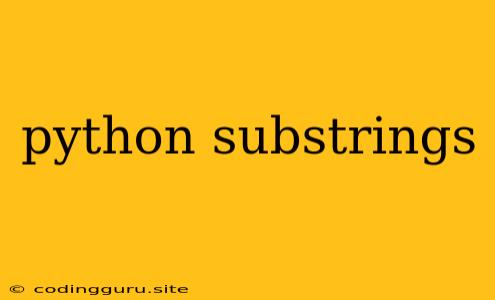Delving into Python Substrings: A Comprehensive Guide
Python, a versatile and popular programming language, provides numerous tools for manipulating strings, including the crucial concept of substrings. Substrings are essentially portions of a larger string, and understanding how to extract and work with them is essential for many programming tasks. This guide will walk you through the intricacies of substrings in Python, providing you with the knowledge and tools to confidently handle them.
What are Substrings in Python?
Imagine a string as a sequence of characters. A substring is a contiguous sequence of characters within that string. It's like taking a smaller slice of the original string. For example:
my_string = "Hello, World!"
substring = "Hello"
Here, "Hello" is a substring of "Hello, World!". It's a contiguous sequence of characters that exists within the larger string.
Extracting Substrings: Slicing the String
The core method for working with substrings in Python is string slicing. This technique allows you to extract portions of a string by specifying the starting and ending indices (remember, Python uses zero-based indexing). Let's explore some examples:
my_string = "Python Substrings"
substring_1 = my_string[0:6] # Extracts "Python"
substring_2 = my_string[7:16] # Extracts "Substrings"
substring_3 = my_string[0:] # Extracts the entire string
substring_4 = my_string[:6] # Extracts "Python" (same as substring_1)
Key points:
- Start index (inclusive): The index of the first character you want to include.
- End index (exclusive): The index after the last character you want to include.
- Omitting indices: Leaving the start or end index blank will default to the beginning or end of the string.
Beyond Basic Slicing: Advanced Substring Techniques
Python offers a wealth of string manipulation tools beyond basic slicing. Here are some essential techniques:
1. Finding Substrings:
-
find(): This method searches for a specific substring within a string and returns the starting index if found, or -1 if not found.my_string = "Python Substrings" index = my_string.find("Sub") print(index) # Output: 7 -
index(): Similar tofind(), but raises aValueErrorif the substring is not found.my_string = "Python Substrings" index = my_string.index("Sub") print(index) # Output: 7
2. Checking for Substrings:
-
inoperator: Checks if a substring is present within a larger string.my_string = "Python Substrings" if "Sub" in my_string: print("Substring 'Sub' found!")
3. Replacing Substrings:
-
replace(): Substitutes all occurrences of a given substring with a new substring.my_string = "Python Substrings" new_string = my_string.replace("Sub", "Super") print(new_string) # Output: Python Superstrings
4. Splitting Strings:
-
split(): Divides a string into a list of substrings based on a delimiter (e.g., spaces, commas).my_string = "Python, Substrings, are, fun!" substrings = my_string.split(", ") print(substrings) # Output: ['Python', 'Substrings', 'are', 'fun!']
Practical Use Cases for Substrings
Substrings are fundamental in many Python programming scenarios:
- Data Processing: Extracting specific information from strings (e.g., names, dates, email addresses) for analysis and processing.
- Text Manipulation: Performing tasks like text formatting, replacing words, and creating custom output.
- String Validation: Checking for the presence of specific substrings to ensure the validity of input data.
- Web Development: Parsing web content, extracting data from HTML code, and creating dynamic web pages.
Conclusion
Mastering substrings in Python empowers you to handle string manipulation with precision. From basic slicing to advanced techniques like find(), replace(), and split(), Python offers a powerful arsenal for extracting and manipulating portions of strings. Understanding these concepts lays a strong foundation for tackling complex string-related tasks, opening up a wider range of possibilities in your Python programming journey.
